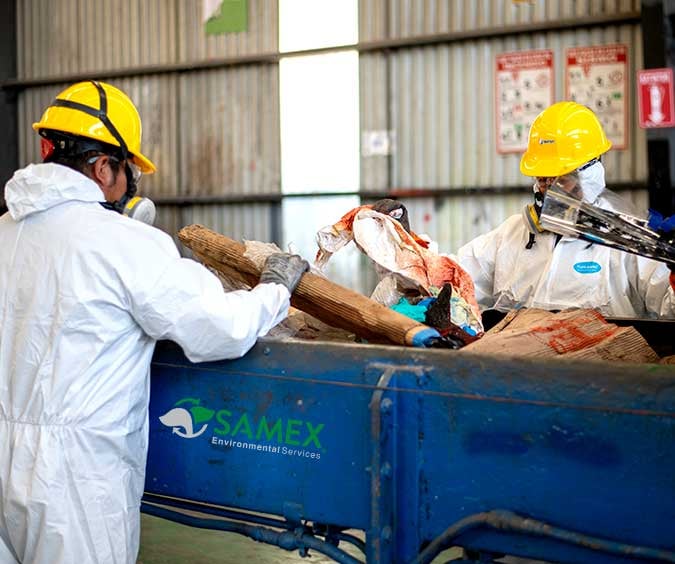Flammable Solids Recycling
From Waste To Energy: Transforming Waste Into Sustainable Energy Solutions
Contact Samex
5-Star Reviews
Happy Customers
Cups of Coffee
Virtual High-Fives


Samex Is Revolutionizing Waste Management Through Flammable Solids Recycling To Ensure a Sustainable Future
Combustible solids are received in drums, cubic yard boxes, and roll-off bins. After inspection, the waste is placed on a conveyor that takes it through magnets to remove unwanted metals. Shredded material goes directly into roll-off bins to be transported 90 miles away to the cement kiln.
Receiving Parameters for Flammable Solids
- Organic solids with >5000 BTU
- Shreddable, without metal or ceramic pieces
- Maybe RCRA, non-RCRA or non-hazardous
- No biohazardous, explosives, fertilizers, agriculture-related pesticides, or herbicides
Taking Recycling & Sustainability To The Next Level
Samex Environmental, however, offers a State-Of-The-Art system that treats waste and turns it into reusable products that are then sold back into the industry.
By ensuring nothing is wasted, companies can take their sustainability initiatives to the next level.
Solids Fuel Blending
Organic solids that can be converted to an alternative fuel are received in drums, cubic yard boxes and roll off bins for processing. Typical solids received are wipes, cardboard, discontinued or expired products, personal protection equipment, and other debris. After weighing the containers and applying the barcode for tracking in the receiving area, the containers are directed to the shredding area. All containers are decanted and thoroughly inspected for constituents that are not compatible with the process, such as metals that will damage the shredder.
The shredder conveyor includes powerful magnets to remove any ferrous metals that were not previously detected. The conveyor continues on to the vibration chamber to remove any fine powders that should not go into the shredder. After waste goes through the shredder, it goes directly into a roll off bin. When the bins are full, they are transported by truck to the local cement kiln that is just 90 miles away.


At Samex We Are Committed To Excellence In The Management Of Hazardous Waste In Harmony With The Environment And Human Health
Driving Sustainability
Providing our clients with a sustainable recycling process to meet their recycling goals for a greener future.
Recycling Responsibility
Our recycling services help serve corporate sustainable policies by embodying responsible resource management and environmental stewardship.
State-of-the-Art Equipment
Our State-of-the-art recycling equipment plays a pivotal role in safeguarding our environment by efficiently processing your waste materials.
Flammable Solids Recycling
Partnering with Samex for your waste management needs not only ensures efficient solutions but also minimizes your company's long-term liability exposure.
Contact Us




Flammable Solids Disposal Process
Combustible solids are received in drums, cubic yard boxes, and roll-off bins. After inspection, the waste is placed on a conveyor that takes it through magnets to remove unwanted metals. Shredded material goes directly into roll-off bins to be transported 90 miles away to the cement kiln.
Combustible Solid Waste Is Received
Customers send their waste to Samex in drums, cubic yard boxes or roll-off bins.

Waste Is Placed On Our Conveyor
Waste is first inspected and then placed on a conveyor. Magnets are then used to remove unwanted metals.

The Waste Material Is Shredded
To ensure the waste material is prepared for further use, it is shredded and stored in roll-off bins.

Prepare Waste For Transportation
Bins are then transported only 90 miles away to cement kilns to be used as an alternative fuel source.

Carbon Footprint Emissions
From Tijuana to Ensenada, Mexico
Miles To Cement Kiln
Cargo Tons
Average truck emits 161.8 grams of CO2 per ton-mile
Total Metric Tons of CO2
The CO2 Emissions Savings Are Significant!
The average carbon emissions output for the same weight-based freight truck from Los Angeles to Benton Arkansas would be 3.4 metric tons of CO2.
Additional Sustainable Resources For Waste Recycling
How Does A Solvent Vapor Recovery System Work?
Larry Burton: Mar 31, 2025
True Or False: Flammable Liquids Are Those That Have A Flashpoint Of 590
Larry Burton: Mar 4, 2025

Feature Example
Asymmetrical butcher kickstarter enamel pin cold-pressed, woke grailed live-edge polaroid. Viral slow-carb stumptown, yr knausgaard health goth asymmetrical.

Feature Example
Asymmetrical butcher kickstarter enamel pin cold-pressed, woke grailed live-edge polaroid. Viral slow-carb stumptown, yr knausgaard health goth asymmetrical.

Feature Example
Asymmetrical butcher kickstarter enamel pin cold-pressed, woke grailed live-edge polaroid. Viral slow-carb stumptown, yr knausgaard health goth asymmetrical.

Feature Example
Asymmetrical butcher kickstarter enamel pin cold-pressed, woke grailed live-edge polaroid. Viral slow-carb stumptown, yr knausgaard health goth asymmetrical.
Let Us Know How We Can Help!
Click the button to launch a pop-up form to contact us.
Let Us Know How We Can Help You.
Complete the form below and one of our specialists will contact you.

